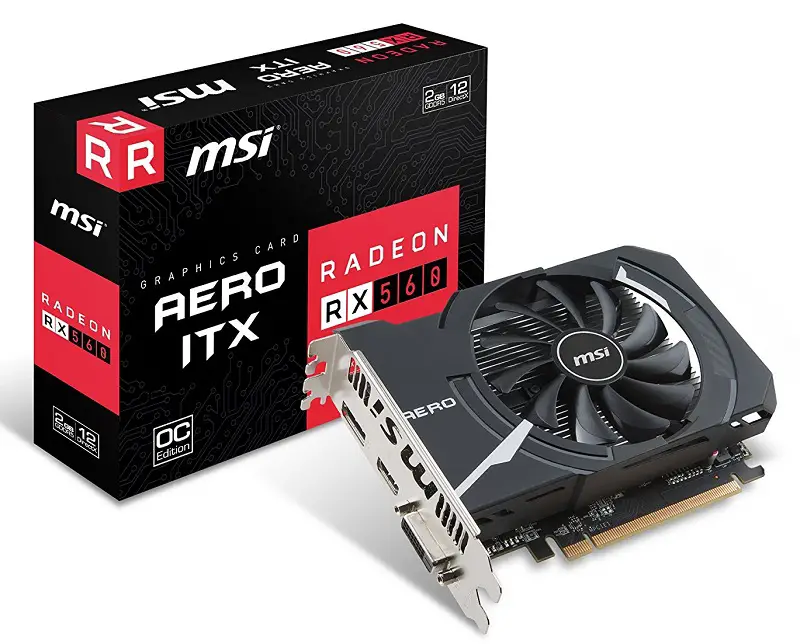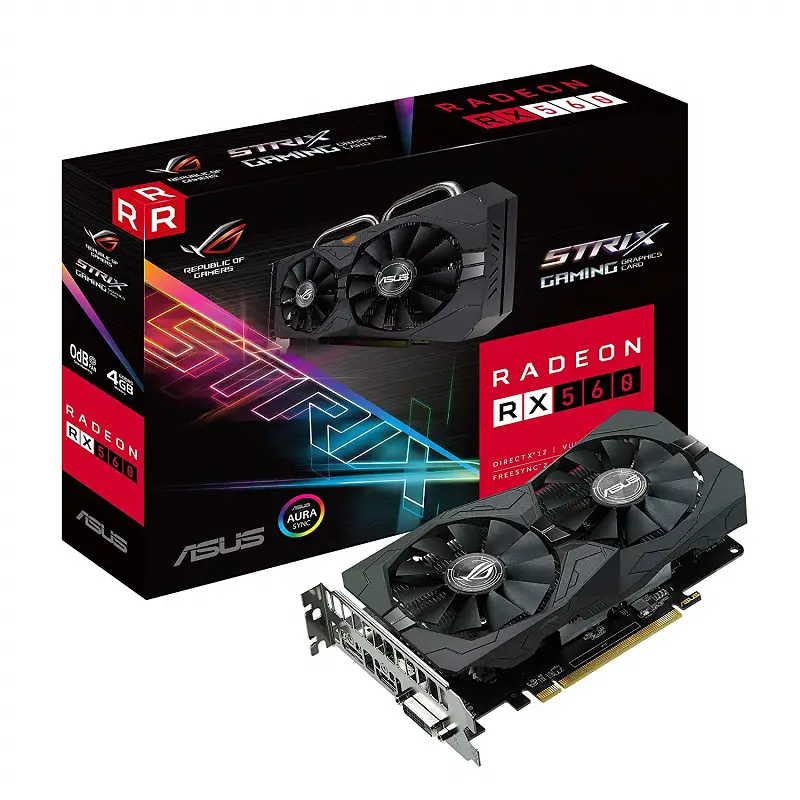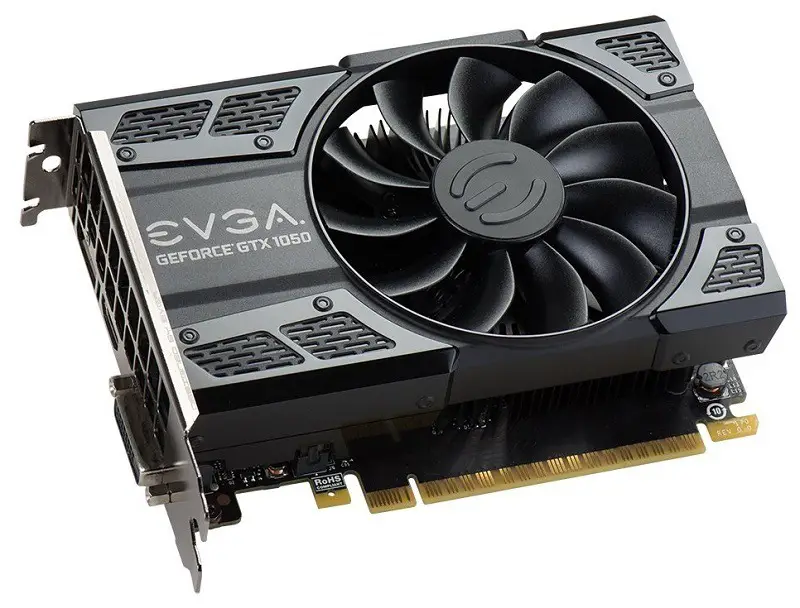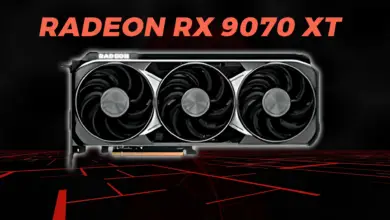For less than $150, there are a couple of graphics cards that are capable of providing a smooth gaming experience. Also, playing games at 1080p doesn’t require you a high-end graphics card.
In fact, there are a lot of budget graphics cards that you can game with easily at 1080p from high to ultra settings. These graphics cards are the sweet spot for budget gamers and give the best performance per dollar spent.
If you really like to play GTA V, the Witcher 3 or Fallout 4 at high settings 1080p, then with any one of these graphics cards you can achieve 40+ fps easily. These are the best choice for gaming builds of $400-$600.
MSI Gaming RX 560 AERO ITX OC 2GB

Rx 560 is one of the latest technology graphics cards from AMD and is 100% DirectX 12 and Vulkan compatible. This card is an entry-level card that comes just below $150 and replaces all the previous cards from AMD as well as Nvidia in this price range. It’s faster than the previous-gen RX series card that was RX 460 and is almost equivalent to GTX 1050 from Nvidia.
In games like Hitman and Doom, the RX series cards including this one give a great boost in performance. The best thing about this card that the TDP is only 60 watts which mean it will draw all the power from the PCI-E X 16 slot itself and you don’t have to buy a high wattage power supply to power this card. It’s similar to the last generation RX 460 which didn’t need this extra power supply but even after the upgrade it still works without an external power connector and performs better than the RX 460.
The card has a basic yet powerful aluminium heat sink from MSI and is the AERO OC edition which not only looks great with grey and white accents but also comes factory overclocked. It has 2GB of memory and a 128-bit memory interface which makes it a good entry-level budget graphics card for playing games at 1080p high settings. Almost all games will perform over 40 fps on high settings but games like CSGO and Overwatch will have no problem running on ultra settings with 60+ fps.
Specs:-
| Memory | 2GB Gddr5 |
|---|---|
| Memory Interface | 128-bit |
| Core Clock | 1196Mhz |
| Stream Processors | 1024 |
| Architecture | Polaris |
| CrossfireX | No |
| DirectX | 12 |
| Outputs | 1xHDMI 1xDVI 1xDP |
ASUS ROG Strix Radeon RX 560

Rx 560 2GB is definitely a good card for the price but when it comes to memory, it sometimes sucks as the standard memory size for 1080p is 4GB. Many games use 4GB memory for maxing out textures and shadows, 2GB version is definitely not able to do that. Although this card is not able to max out at 1080p, 4GB of VRAM is good for games like GTA V and Middle Earth: Shadow of Mordor.
The clocks and other specs are the same, only the VRAM is increased in this Asus ROG Edition. As a result, with paying a little more price, you can end up getting a very good entry-level graphics card that can not only play some of the latest titles on high settings but is also better in some future-proofing as newer games use more memory.
Specs:-
| Memory | 4GB Gddr5 |
|---|---|
| Memory Interface | 128-bit |
| Core Clock | 1285Mhz(OC Mode) |
| Memory Clock | 7000Mhz |
| Architecture | Polaris |
| CrossfireX | Yes |
| DirectX | 12 |
| Outputs | 1xHDMI 1xDVI-D 1xDP |
EVGA Geforce GTX 1050 2Gb Gddr5

The GTX 1050 2GB is the newest release from Nvidia and is based on the Pascal architecture GP107. This is the most power-efficient graphics card from Nvidia’s side and similar to the RX 560 it has a TDP of 75 watts and has no 6 pin power port. It means that there isn’t headroom for overclocking with this card. But currently, EVGA is the only brand that is the cheapest of all, it’s fairly a good deal.
With GPU Boost you will still get a little performance boost which may not be very big but definitely, I agree with not providing these with extra power ports for overclocking as these are entry-level cards and they won’t give you a boost from 40fps to 50 fps.
This card has 2GB of gddr5 memory, 640 Cuda cores which are equal to the specs of the GTX 750 Ti Maxwell family graphics card if you remember it. But when you compare the performance of GTX 1050 with that of GTX 750 ti, it not only beats it by up to 40% but also beats the previous generation 900 series card which was the GTX 950 which used to cost around $200.
If you want a card that can play all the games on high settings at 1080p with 40-50 fps, then this is for you. And if you like 60 fps then you can put the settings to medium instead of high and still enjoy good graphics with buttery smooth 60+ fps.
Related: $400 gaming build
Specs:-
| Memory | 2GB Gddr5 |
|---|---|
| Memory Interface | 128-bit |
| Core Clock | 1354Mhz/1455Mhz boost clock |
| Cuda Cores | 640 |
| Architecture | Pascal |
| SLI | No |
| DirectX | 12 |
| Outputs | 1xHDMI 1xDVI-I 1xDisplay Port |
Important things to know before you buy a Graphics card
1. Price and Requirements
Price
Make sure before you buy a graphics card, you know your budget. You can have $100 or even $500 for buying a GPU but if you are going to build a completely new PC then defining and distributing the expenditure between different components is a little difficult. If you are buying a new PC, then make sure you don’t buy an overkill graphics card for your CPU. A Pentium processor can’t handle RTX 2080 or GTX 1080 Ti. Similarly, a GT 1030 is too slow for an i7 9700K.
Requirements
Another important thing is to define your requirements. Without knowing what you want, you can either overspend or underspend on your graphics card. If you are just starting out and want to enjoy some eSports or Casual games then a budget graphics card will be enough for the job. But in case you want to enjoy the games on ultra textures at 1080p or higher resolution then you will need to buy higher-end graphics cards like GTX 1070 or RTX 2080 etc.
2. VRAM
VRAM is the memory that is different from the main system RAM and is only dedicated to providing the horsepower your graphics need. Every dedicated Graphics card has some dedicated VRAM which now in modern GPUs can vary from 1GB up to 16GB.
To play games on higher settings at 1080p at least, you need to have around 3-4GB VRAM on your Graphics card. If you go lower than that, then you may have to lower down some of the settings in your games for getting good frames per second.
If you want to max out textures, anti-aliasing, foliage, shadows etc. in a AAA game, then you will need at least 6GB of VRAM that is present in GTX 1060 and higher-end Graphics cards. Right now, I don’t know of any game that utilizes more than that except in the case of higher resolution like 4K.
3. Cooling
Low Profile graphics cards have smaller heatsinks and therefore aren’t efficient in maintaining good temperatures if you overclock them but graphics card with bigger aluminium heatsinks with copper heat pipes with 2 or more fans are extremely useful for maintaining good temperature even while overclocking to the full potential. If you are not doing any type of overclocking, you should still make sure that your PC chassis has enough ventilation for proper air intake and exhaust.
4. Power Supply
Different graphics cards have different TDP and their power consumption vary. So, you need to check the graphics card’s TDP before buying it. Make sure your power supply is having enough wattage capacity to run your whole system without any bottleneck.
A system that uses low end or budget components will have no problem in running on a 400 watts reliable power supply but when it comes to running a GTX 2080 Ti, i7 9700K, Multiple Fans, AIO coolers, and several storage devices, then you will need a higher wattage power supply. Make sure you check the TDP of all of your components and see if your PSU still has enough wattage capacity to power your Graphics card.
Another important thing to note is the graphics card power ports. Make sure your Power supply has those power connectors that your graphics card requires. A GPU with a 6-pin port will use a 6-pin power connector from the power supply.
Generally, almost all the budget power supplies in the modern day have a 6-pin power connector at the minimum. If your graphics card has 2x 8-pin power ports, your PSU must have those in order to run the graphics card with stability.
5. I/O Connectors
Sometimes a particular graphics card from a different manufacturer will not have the I/O ports for connectivity as your monitor requires to show the display. Check the I/O ports at the back of your monitor and also the I/O ports of the graphics card you are buying.
If your monitor is a 144Hz gaming monitor, then you must have a DVI port or a DP port on your monitor/GPU to get those 144Hz refresh rate smoothness. Make sure both your graphics card and monitor have these ports to avoid mishappening.

Thanks! I’m considering upgrading my older Nvidia GeForce 550 ti, and this article is helpful. I’m going now to check out your article on the $150-$200 boards.
Thanks Joy. Definitely the graphics cards for $150-$200 are best for 1080p.